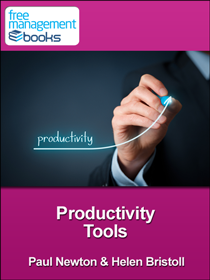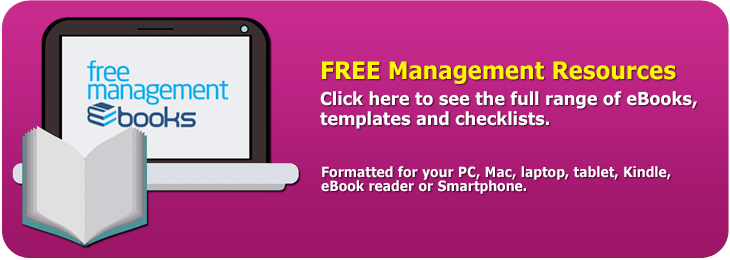Time Management Productivity Tools - Free eBook in PDF, Kindle and ePUB Format
 |
 |
 |
Book Description - ISBN 978-1-62620-985-5 (42 Pages)
There are personal productivity tools available for planning, scheduling, task prioritizing, monitoring, and much more besides. Some of these tools are technology-based whilst others need nothing more than a pencil and paper. This free eBook explains how to choose the best tools for your own particular needs and describes how to use them to boost your productivity.
Chapter 1 - Time Management Productivity Tools
Personal productivity tools are useful but they are no substitute for adopting the right behaviors . Personal productivity tools include: the urgency/importance grid, ABC analysis, Pareto analysis, the reverse schedule, the closed to do list, calendar tools, to do list tools, launcher and hot key tools, monitoring tools and miscellaneous productivity tools.
Chapter 2 - Time Management Urgency/Importance Grid
An urgency/importance grid is a quick and easy way to help you prioritize tasks. Even though the placement of tasks on the grid is highly subjective, it is often better than just looking at a list of tasks.
Chapter 3 - Time Management ABC Analysis
The ABC categorization is another quick way of helping to prioritize tasks. Try it as well as the urgency/importance grid and see which one you prefer.
Chapter 4 - What is a Time Management Pareto Analysis
The Pareto Analysis is a useful technique for prioritizing problem-solving work, enabling you to ensure that the first piece of work you complete also resolves the greatest number of problems.
Chapter 5 - Time Management Reverse Schedule
A reverse schedule is a way of setting milestones and a start date by working backwards from the required task's completion date. Even though it is a relatively straightforward process to perform, many people do not allocate sufficient time to allow the planning benefits of creating a reverse schedule to be realized .
Chapter 6 - Time Management Closed To Do List
A closed list is one where nothing can be added to it, until all its items have been completed. It is designed so that all of the items will be finished within a specific time frame, for example, an afternoon, a day or a week.
Chapter 7 - Time Management Calendar Tools
There are dozens of calendar applications available but your best option will probably be one that the people you work with can share. If this is not an issue for you, then 'Google Calendar' would be a good choice, but you may also want to look at '30 Boxes' and 'Backpack' before you make a final decision, as they both have extensive functionality and are worth investigating.
Chapter 8 - Time Management To Do List Tools
These are an essential productivity tool and are well supported by both free and low cost applications. Choosing something that integrates well with your calendar and can be shared with other members of your team are probably the most important considerations.
Chapter 9 - Time Management Launcher and HotKey Tools
These tools are designed to save time by reducing the number of keystrokes that you need to make. Whether this is worth investing in will depend upon how many times a day you perform a particular task or series of keystrokes that could be pre-programmed.
Chapter 10 - Time Management Monitoring Tools
If you find it difficult to avoid wasting time on sites like FaceBook, LinkedIn and Twitter as well as personal email, then you should consider using a tool to block access to these distractions during your core working hours.
Chapter 11 - Time Management Productivity Tools
There are literally hundreds of productivity tools available on the Internet, many of these tools are free or sold for a nominal price and cover a wide variety of activities. You need to decide which of your every day activities or tasks take up more of your time and effort than you feel is reasonable. When you have this list, you can then research the best available productivity tool for you.
| You will learn: |
|
![]()
![]()
Told Me What Tools There Are Out There
This book was really interesting. I had no idea there were so many tools that I could use to help me with my time management. Some of the software tools that are described are free to download from other sites and are absolutely brilliant. I've been meaning to get a password manager and a 'waste of time' website blocker for ages but I didn't know what to choose. This book told me what tools there are out there and what they do so I could make a good choice. There is also some information on decision making tools that I had never heard of which are easy and quick to use. Recommended.
Christine Silverstone
Contains an Excellent Example of Pareto Analysis
The first half of the book describes some simple planning and decision making tools and there is an excellent example of how to use a Pareto analysis which you can use to make and justify decisions when you are prioritizing work. This is a method that I already use but anyone who is not familiar with it will benefit from seeing it explained so clearly.
The second half of the book deals with software productivity tools. Obviously, these are evolving and the book gives a general overview and then points you to the relevant website rather than going into a lot of detail about each one. The authors are very realistic about how much time software tools can save you. I agree with them that you need to sort out your priorities and work flow first because that will make the most difference to your productivity. Having said that, I did learn that there were some software utility tools I didn't know about and that that could save me a few minutes here and there. Although as the book points out this won't make a lot of difference to your productivity it can make some tedious tasks less less of a pain.
I read the first half of this book in about ten minutes (allow 15-20 if you're not already familiar with the techniques) and the second half I skimmed in about 5 minutes. I downloaded this eBook out of curiosity and I was amazed to find that its about 40 pages of good quality content. For a free book I thought it was very good indeed.
Rob Watts
Changed My Approach to Time Management
I'm someone who has my own business, so for me, productivity is extremely important if I want to get somewhere. I used to think productivity meant getting the latest gadgets and software to help me stay productive, but I had to very quickly admit to myself that the software was not helping my productivity. I was lacking in self-discipline. Instead of making time to plan things out, I was trying to enter data into my software which, at the time, was not necessary. I eventually found out that all my fancy software was my biggest distraction, so I had to change my approach or I'd lose my business.
I stumbled upon this e-book and was amazed by what I read when it comes to productivity and time management. Time management was something I had completely overlooked. While I may have been spending nearly twelve hours at my office attempting to do work, I was, in reality, only working towards my business for half the time or less, when I wasn't distracted by the latest gadgets or software.
The book first helped me understand that I need to know what my business needs, including software, and how much time I needed to put in, how much organization I needed, how to plan my tasks, etc. My entire approach changed when I decided I needed to think things through before diving headfirst into my business.
First I had to plan out tasks, goals, etc. I could easily do this with a piece of paper and a pencil. All I had to do was write down what needed to be done. The book explained that this was known as a Reverse Schedule or an Urgency/Importance Grid. For the next part, marking things down on the calendar, the book explained that using software would be beneficial since there are great programs on the market these days that can alert you of an appointment or remind you of a task.
After laying down a strong foundation for my business, and being better about my time management, managing my business was a lot easier and much more efficient. As long as I planned out my tasks, scheduled what I needed to do and when, and monitored my customers, I could easily figure out ways to get them to approach my website and business. I could also make my business much more appealing to my customers after knowing what they were looking for and needed from me.
I recommend this e-book to anybody who is serious about getting their business off the ground and someone who is willing to work on the little details. This book goes into the small details needed to help a business grow efficiently and effectively, and if followed properly, there is no reason why a business should not benefit. Once you learn the right behaviors, there should be no stopping you from achieving everything you want your business to be.
Mike Randall
Time Management Skills Examples - These include adopting a 'one-touch' approach to incoming paperwork, optimizing your workspace for efficiency and developing an efficient filing system for electronic documents.
Time Management Strategies - If you want to learn to manage your time better, the first step is to document how you are currently spending it. Surprisingly, most of us do not have an accurate picture of how we spend our time. We may think that we know how long we spend on each task, but these impressions usually turn out to be inaccurate when compared to a detailed time log.
Time Management Tips - Effective time management involves learning to focus on the right things whilst letting go of some of the less important tasks. Whilst time management forwards many proven techniques, you will need to develop a strategy that suits your own needs.
Effective Time Management - Interruptions during the working day not only take up your time, they also have a secondary impact - in that they cost valuable minutes as you get back into what you were doing before the interruption. Some workplace interruptions may be unavoidable, but many are not and you shouldn't feel guilty about reducing your exposure to interruptions as the result will be an increase in your overall efficiency.
Decision Making Techniques - Decision making is an important aspect of time management. For example, when classifying activities on the urgency/importance grid, you will need to be decisive and not procrastinate over each and every activity. Having decided what is important, you then need to progress these tasks quickly and efficiently, and once again decision making will be a key factor in your ability to do this.
Are All of Your Goals SMART - In team or project environments, SMART goals are essential. The clarity of the goal, along with its defined measures and relevance to the project, ensure all members know exactly what is required of them and by when.


